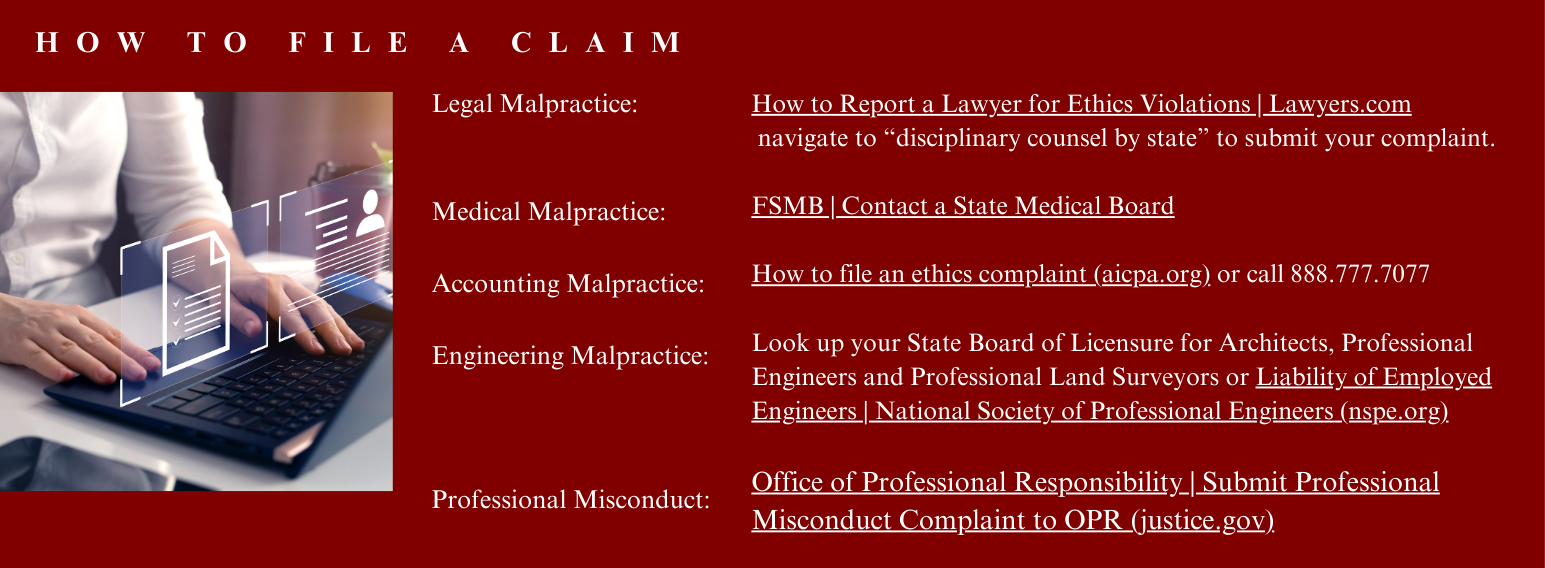Professional Malpractice

Professional malpractice, also known as professional negligence, occurs when a licensed professional fails to perform their duties competently, resulting in harm or injury to their clients or patients. While professionals are expected to adhere to certain standards of care and ethics, instances of malpractice can still occur across various industries, including healthcare, legal services, accounting, and beyond. In America, individuals can take proactive steps to protect themselves from potential malpractice and seek resolution through mediation when disputes arise. This article delves into the complexities of professional malpractice, provides guidance on safeguarding against negligence, and explores the role of mediation in resolving malpractice claims.
Professional malpractice encompasses a wide range of negligent actions or omissions by licensed professionals. There are five predominant areas where professional malpractice is consistent.
Medical Malpractice
Negligence or errors committed by healthcare providers, such as doctors, nurses, surgeons, or pharmacists, that result in patient harm, misdiagnosis, surgical errors, medication mistakes, failure to provide appropriate treatment, and possible death. According to medical malpractice statistics, 250,000 people die due to medical errors and negligence every year with 99 percent of physicians facing at least one lawsuit before the age of 65. The National Practitioner Data Bank figures state that New York has the highest amount of malpractice payments equating to $7.025 billion and North Dakota with the lowest compensation relief at $28.35 million[i].
Legal Malpractice
This is when legal parties involved are guilty of breach of duty or negligence by attorneys, lawyers, or legal professionals in handling legal matters, including failure to meet deadlines, inadequate representation, conflicts of interest, or failure to disclose information. In 2018, disciplinary agencies received 83,073 complaints in 45 states that resulted in 2,872 lawyers being publicly disciplined, with 48% of those within the same group being suspended and 631 disbarred[ii]. Proving legal malpractice is one of the most difficult and expensive malpractice claims to pursue. In this kind of negligence situation, connecting with an attorney specializing in legal malpractice claims is advisable.
Accounting Malpractice
Errors, omissions, or fraudulent activities by accountants, auditors, HR accounts payable, or financial professionals that result in financial losses, misrepresentation of financial information, fraud, or failure to comply with accounting standards qualify as accounting malpractice. Accountants are obligated to abide by Generally Accepted Auditing Standards (GAAS) and Generally Accepted Accounting Principles (GAAP). When an accountant deviates from the standards of the GAAS and GAAP, this can result in legal actions that threaten the accountant’s practice. In contrast, billing fraud or errors from HR or external vendors are the most common forms of accounting malpractice that stem from a lack of checks and balances within the organization. All of which can result in compensation for damage to their victims[iii].
Engineering Malpractice
Engineering negligence or design errors by engineers, architects, or construction professionals that lead to structural failures, building defects, or unsafe conditions. Compared to other professional practices, engineering standards are obligated to protect the safety and public welfare and may involve multiple parties versus other practices that deal with clients. This makes engineering professionals more susceptible to negligence and the impact of error devastating to the masses[iv].

Professional Misconduct
Violations of ethical standards or professional codes of conduct by licensed professionals, including conflicts of interest, breach of confidentiality, or failure to disclose conflicts within business atmospheres.
Best Practices to Protect Yourself
To protect oneself from potential malpractice, individuals and business owners can take precautions that involve research and due diligence. Conduct thorough research and due diligence before engaging the services of a professional. Check their credentials, qualifications, and reputation within their field. Seek Recommendations or referrals from trusted sources, such as friends, family members, or professional networks, when selecting a professional service provider. Carefully review contracts, agreements, or engagement letters with professionals to understand the scope of services, fees, and responsibilities. Always keep detailed records of all communications, transactions, and interactions with professionals, including emails, contracts, invoices, and receipts. Don't hesitate to ask questions, seek clarification, or voice concerns if you're unsure about the services provided or recommendations given by professionals.

The Role of Mediation in Resolving Professional Malpractice Claims
When disputes arise due to professional malpractice, mediation offers a constructive and cost-effective alternative to litigation for resolving conflicts and reaching mutually acceptable solutions. In mediation, a trained mediator facilitates communication and negotiation between the parties, helping them explore interests, identify underlying issues, and develop creative solutions.
Mediation proceedings are confidential and conducted on a voluntary basis, allowing parties to discuss sensitive issues openly and explore settlement options without fear of admissions being used against them in court. Conflict resolution also grants flexible and collaborative approaches that maintain control over the outcome and tailor solutions to their unique needs and interests, rather than relying on a judge or jury to impose a decision.
In situations between family, friends, business partners, clients, or mergers and acquisitions mediation focuses on preserving relationships and promoting understanding between parties, which can be especially beneficial in professional malpractice cases where ongoing professional relationships may be at stake. By providing efficient and timely resolution, mediation can lead to quicker and more effective outcomes of disputes compared to traditional litigation, saving time, resources, and emotional energy for the parties involved.
Professional malpractice poses significant risks to individuals and organizations, potentially leading to financial losses, reputational damage, and harm to individuals' well-being. By taking proactive steps to protect themselves and seek resolution through mediation when disputes arise, individuals can mitigate the impact of malpractice and work towards fair and equitable solutions that uphold their rights and interests. Mediation offers a collaborative, confidential, and effective process for addressing professional malpractice claims and promoting positive outcomes for all stakeholders affected by negligence.
[i] New Medical Malpractice Statistics by State (rosenbaumfirm.com)
[iii] What Is Accounting Malpractice? | King & Jones (chicagobusinesstriallawyers.com)